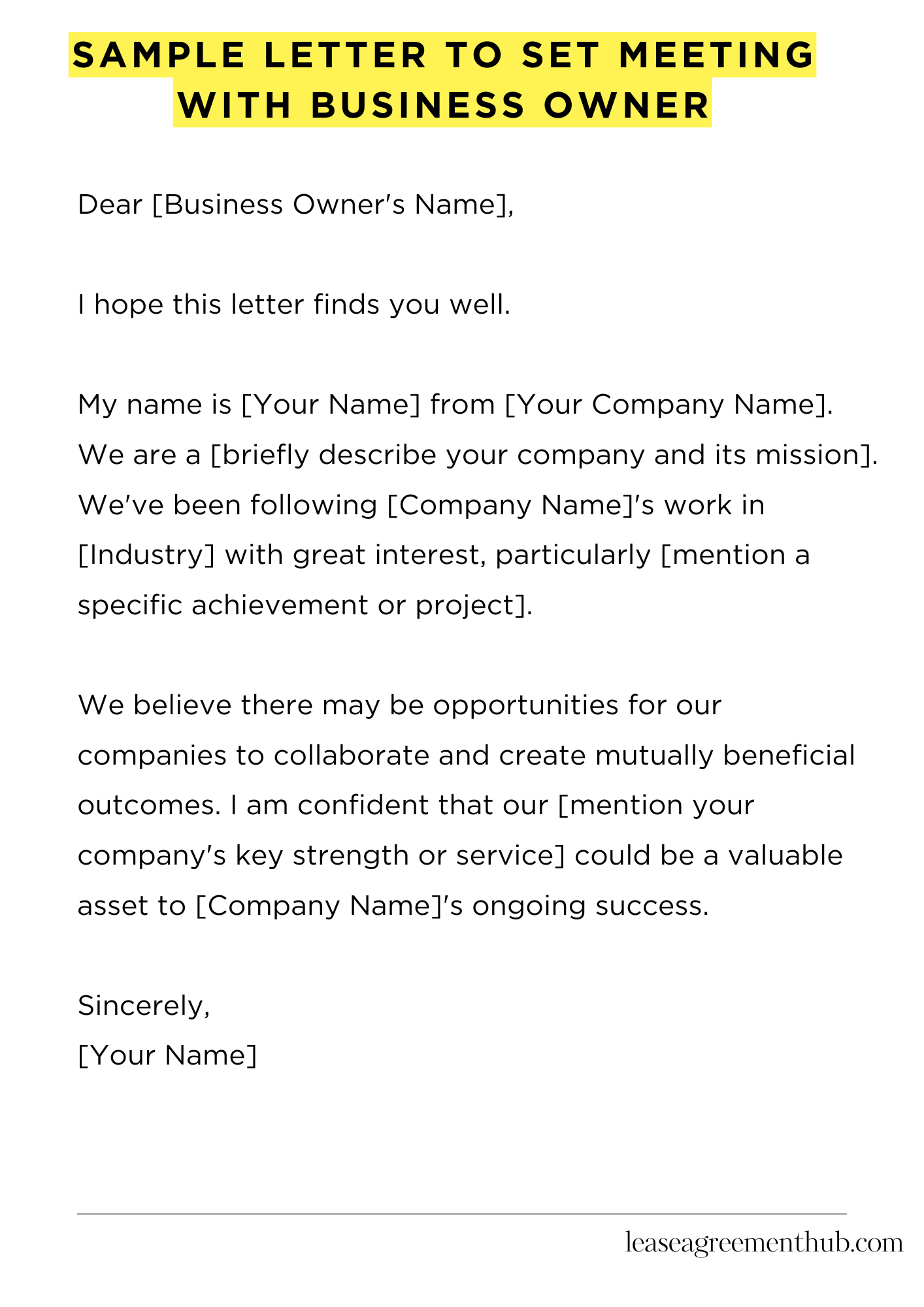Need to meet a business owner? You might need a letter to set up that meeting. This letter clearly and politely requests a meeting. It’s used when you want to discuss potential partnerships or services.
This article is your go-to resource. We’ll share ready-to-use letter samples. These templates will make your life easier.
Get ready to craft the perfect meeting request. Let’s explore some effective sample letters. You will be all set!
Sample Letter To Set Meeting With Business Owner
[Your Name/Company Name]
[Your Address]
[Your Phone Number]
[Your Email Address]
[Date]
[Business Owner’s Name]
[Business Owner’s Title]
[Company Name]
[Company Address]
Subject: Exploring Opportunities for Collaboration
Dear [Business Owner’s Name],
I hope this letter finds you well.
My name is [Your Name] from [Your Company Name]. We are a [briefly describe your company and its mission]. We’ve been following [Company Name]’s work in [Industry] with great interest, particularly [mention a specific achievement or project].
We believe there may be opportunities for our companies to collaborate and create mutually beneficial outcomes. I am confident that our [mention your company’s key strength or service] could be a valuable asset to [Company Name]’s ongoing success.
I would appreciate the opportunity to schedule a brief meeting to discuss potential synergies in more detail. Would you be available for a call sometime during the week of [Suggest a week]? I am flexible and can adjust to your schedule.
Thank you for your time and consideration. I look forward to hearing from you soon.
Sincerely,
[Your Name]

How to Write Letter To Set Meeting With Business Owner
Subject Line: Crafting Initial Intrigue
- Be succinct. Aim for clarity, not cleverness, in your subject line.
- Personalize it if feasible; mentioning a mutual acquaintance or a specific business achievement can be advantageous.
- Avoid hyperbole. “Revolutionary Opportunity” sounds like spam. Opt instead for something like “Discussion Regarding [Industry] Trends.”
Salutation: Establishing Rapport
- “Dear Mr./Ms./Mx. [Last Name]” is the gold standard. Investigate the owner’s preferred honorific if unsure.
- Never use “To Whom It May Concern.” It’s impersonal and signals a lack of due diligence.
- If you know the business owner’s first name and have a prior connection, using it can be more affable, but err on the side of formality initially.
Introduction: Hook, Line, and Sinker
- Concisely state your purpose. Don’t bury the lede.
- Mention how you became aware of their business. This establishes context and shows you’ve done your homework.
- Include a brief value proposition. What benefit can you offer them?
Body Paragraph 1: Articulating Value
- Elaborate on the benefit you mentioned in the introduction. Provide concrete examples or data if possible.
- Demonstrate an understanding of their business challenges. This shows empathy and insight.
- Avoid jargon. Speak their language, not your own.
Body Paragraph 2: The Meeting Proposal
- Propose a specific date and time for the meeting, or offer a couple of options. This makes it easy for them to say yes.
- Specify the anticipated duration of the meeting. Respect their time constraints.
- Reiterate the value they’ll gain from the meeting. Remind them what’s in it for them.
Closing: Expressing Gratitude and Enthusiasm
- Express your appreciation for their time and consideration. Politeness is paramount.
- Reiterate your enthusiasm for the opportunity to connect. Show them you’re genuinely interested.
- Use a professional closing such as “Sincerely” or “Best Regards.”
Signature and Contact Information: Ensuring Accessibility
- Include your full name, title, company, phone number, and email address. Make it effortless for them to reach you.
- Consider adding a link to your LinkedIn profile or company website. This provides additional context and credibility.
- Proofread meticulously. Even a minor typo can undermine your professionalism.
Frequently Asked Questions: Sample Letter to Set Meeting with Business Owner
This section addresses common queries regarding composing a sample letter to request a meeting with a business owner.
Understanding best practices can significantly increase the likelihood of securing a meeting.
What is the primary goal of the letter?
The primary goal is to clearly and concisely request a meeting, highlighting the potential value and benefit to the business owner.
What information should the letter include?
The letter should include your name, affiliation, reason for requesting the meeting, a brief overview of potential benefits, and proposed meeting times.
How should the letter be formatted?
The letter should be formatted professionally, with a clear and concise structure, using formal language and proper grammar.
How long should the letter be?
The letter should ideally be kept to one page to respect the business owner’s time and maintain their attention.
What is the best way to follow up after sending the letter?
Follow up with a brief phone call or email within a week of sending the letter to confirm receipt and reiterate your interest in meeting.
Related: